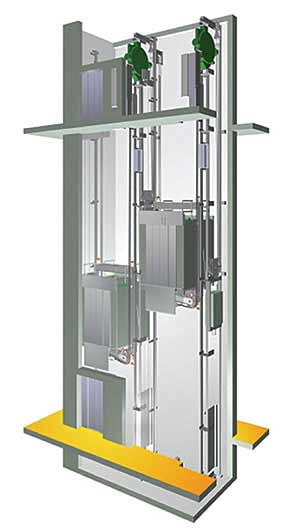New Elevator Technology: The Machine Room-Less Elevator
Â
|
Â
Energy Savings and Environmental Impacts
The new PMSM technology also means energy savings, which not only reduces building operations costs, but can positively impact the U.S. Green Building Council's LEED® Rating System calculations. PMSMs are 93 percent efficient or better, a favorable comparison to the typical 65 percent efficiency of traditional machines. The direct energy costs associated with elevator operation drop significantly with modern systems. The new gearless motors typically use 40 percent to 60 percent less energy than traditional traction or hydraulic motors. This can mean a savings of a few thousand kilowatt-hours per year for a single elevator, and up to tens of thousands of kilowatt-hours for multiple banks of elevators.
Also contributing to the energy efficiency of the MRL is the lower starting current required. The PMSM uses just 30 percent to 40 percent of the energy of comparable traction and hydraulic motors. Typically, an AC gearless low-rise elevator with a PMSM has less than a 10 horsepower (hp) motor, compared to motors of up to 40 hp for traction elevators and up to 60 hp for hydraulic motors.
Consider a 3,500-pound-capacity commercial elevator with seven landings and 60 feet of travel (or rise). A traditional geared machine uses an estimated 348,058 kWh of electricity in a single year, which, applying a rate of $0.072 per kWh, results in annual electrical costs of $25,060. A PMSM-driven elevator uses about 193,446 kWh of electricity per year. At the same utility rate, the estimated annual energy costs amount to $13,928-a savings of $11,132 or 44 percent per year. For the 30-year functional life of the building, savings would exceed $330,000.
Sustainable technology and design means much more than just saving energy. It includes eliminating or reducing risks of damaging the environment and reducing use of nonrenewable resources. MRL technology removes the need for a plunger and cylinder and thus eliminates the risk of accidental environmental contamination. Hydraulic elevators, on the other hand, employ oil-based fluids to move the elevator, which can leak and cause damage. (It should be noted, however, that current elevator code requires all buried plunger and cylinders to be protected from corrosion with a means to monitor the cylinder. As mentioned, this is typically achieved utilizing a PVC casing.)
Â










